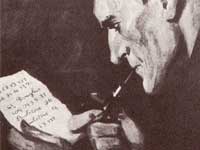 While I was reading The Adventures of Arthur Conan Doyle, I came across the following passage in which Conan Doyle described his reasons behind moving Sherlock Holmes from the original format of serialised novels into self-contained short stories—a move he credits with at least part of the detective’s subsequent success:
While I was reading The Adventures of Arthur Conan Doyle, I came across the following passage in which Conan Doyle described his reasons behind moving Sherlock Holmes from the original format of serialised novels into self-contained short stories—a move he credits with at least part of the detective’s subsequent success:
[…] Conan Doyle identified a fundamental truth about the magazine market: he argued that a series, as distinct from a serial, made more sense for the majority of readers. ‘Considering these various journals with their disconnected stories, it had struck me that a single character running through a series, if it only engaged the attention of the reader, would bind that reader to that particular magazine. On the other hand, it had long seemed to me that the ordinary serial might be an impediment rather than a help to the magazine, since, sooner or later, one missed one number and afterwards it had lost all interest. Clearly the ideal compromise was a character which carried through, and yet instalments which were each complete in themselves, so that the purchaser was always sure that he could relish the whole contents of the magazine. I believe I was the first to realise this.’
The quote is from Conan Doyle’s 1924 autobiography, Memories and Adentures, but the insight he describes would have struck him between 1890, when the second Holmes novel The Sign of the Four was serialised, and 1891 when the first short story, A Scandal in Bohemia, appeared.
It’s interesting that now, around 120 years later, TV networks are still struggling with exactly this balance.












